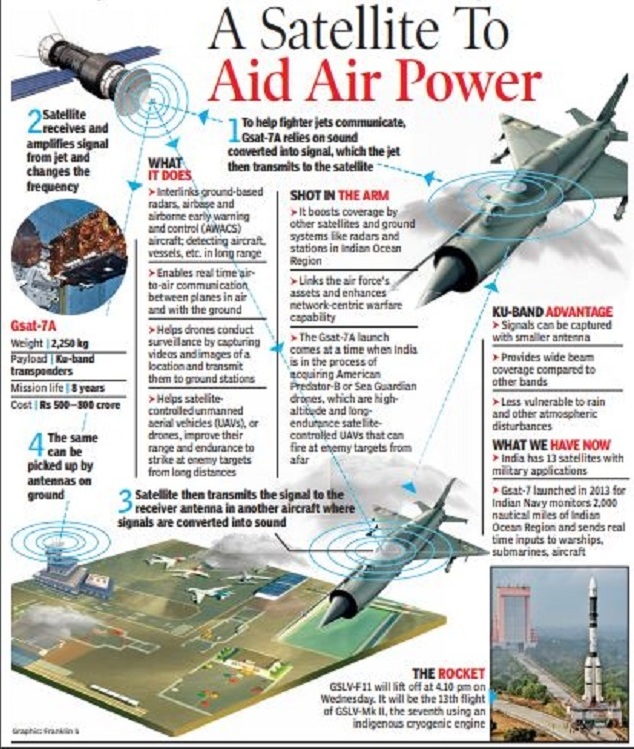Why in news?
ISRO launched the communication satellite, GSAT-7A with GSLV-F11 (Geosynchronous Satellite Launch Vehicles).
What is GSAT-7A?
- GSLV-F11 injected GSAT-7A into a Geosynchronous Transfer Orbit (GTO) very close to the intended orbit.
- GSAT-7A is an advanced communication satellite with a Gregorian Antenna and other new technologies.
- GSAT-7A is the 39th Indian communication satellite of ISRO to provide services to users in Ku-band over the Indian region.
- The satellite operating in the Ku band will service communication needs for network-centric operations of the Indian Air Force and the military.
- Most of the functional requirements of the communication payloads and other systems have been derived from ISRO’s earlier geostationary INSAT/GSAT satellites.

What is the key feature?
- At 2,250 kg, GSAT-7A is the heaviest satellite launched by GSLV-Mk-II since it began using the indigenous cryogenic engine.
- The cryogenic stage of this vehicle has been modified to increase the thrust rate.
- The rocket was pushing the limits of its capabilities in launching satellites of the two-tonne class for the seventh time.
- This is a standout factor with this launch and 12 other successful flights carried out so far by ISRO’s GSLV-Mk-II rocket.
- They include six successive flights since 2014 with an indigenous cryogenic fuel upper stage.
What is ISRO's GSLV programme?
- GSLV-Mk-II is ISRO’s fourth generation rocket with three stages.
- The first stage has four liquid strap-ons and a solid rocket motor.
- The second has a high thrust engine using liquid fuel, and the third is the cryogenic upper stage.
- The indigenous cryogenic engine was tested successfully for the first time in 2014.
- The cryogenic stage uses liquid hydrogen as fuel and liquid oxygen as an oxidiser.
- Compared to solid and earth-storable liquid propellant stages, it is a highly efficient rocket stage that provides more thrust for every kg of propellant it burns.
- ISRO initially used 7 cryogenic engines sold by Russia for the early phase of its GSLV programme that began in 2001.
- GSLV launches with Russian engines have had mixed success, with only two flights performing well.
- ISRO is developing a more powerful, fifth-generation GSLV-Mk-III rocket to launch satellites in the 4-6-tonne category.
- GSLV-Mk-III had a successful development flight recently when it launched the 3,423-kg GSAT-29 communication satellite.
- GSLV-Mk-III is the designated launch vehicle for India’s upcoming second moon mission and the first human space flight scheduled for 2022.
Source: Indian Express
